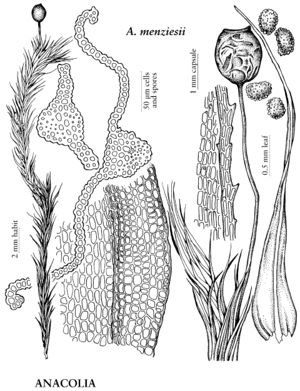Plants small to large, in lax to dense tufts. Stems erect or sometimes decumbent, simple, 2-fid, fastigiate, or with subfloral whorl of branches, usually tomentose proximally. Leaves erect-appressed to spreading-recurved, ovate-lanceolate, lanceolate, or linear; base sometimes abruptly enlarged and clasping; margins not or weakly bordered, toothed distally or throughout, teeth single or paired; apex acute, acuminate, or rarely obtuse; costa strong; laminal cells rounded quadrate, oblong, rectangular, or linear, prorulose or mammillose at one or both ends, rarely centrally papillose or smooth, walls usually firm, usually enlarged, lax, smooth, and hyaline toward base, not or weakly differentiated at basal angles (or with distinct alar regions). Sexual condition dioicous, autoicous, or synoicous; perigonia gemmiform or discoid, paraphyses filiform or clavate; perichaetial leaves similar to stem leaves, often longer, areolation more lax. Seta terminal, often appearing lateral by innovations, single or rarely clustered, usually elongate, smooth. Capsule inclined, horizontal, erect, or rarely pendent, subglobose or ovoid, usually asymmetric, furrowed or rarely smooth or irregularly wrinkled when dry, mouth usually oblique; annulus usually absent; operculum conic, convex, umbonate, or rarely rostrate, beak short, blunt; peristome double, single, rudimentary, or absent, inserted well below mouth; exostome teeth 16, yellow-brown to reddish brown, lanceolate, smooth or papillose, usually unbordered, usually with prominent trabeculae, often with intermediate thickenings distally; endostome absent or usually well developed, sometimes adhering in fragments to exostome or shorter and keeled, basal membrane usually high, segments gaping, split along median line, cilia 1–3 or sometimes absent, usually short, never appendiculate. Calyptra cucullate, smooth, naked. Spores spheric to reniform, papillose.
Distribution
Nearly worldwide, montane tropical regions.
Discussion
Genera 9 or 10, species ca. 420 (5 genera, 22 species in the flora).
Distinctive family characters of Bartramiaceae include the more or less globose, typically furrowed capsules and the narrow leaves with prorulose cells. The prorulae are usually eccentric over the lumen. Infrequently, most of the laminal cells are smooth (a condition often associated with submergence in boggy habitats) or, as in Plagiopus, the leaves develop a striated cuticle that can appear papillose in transverse section.
Selected References
Lower Taxa
Illustrations
| Family ⠉ | Taxon | Illustrator ⠉ | |
|---|---|---|---|
 | Bartramiaceae | Anacolia menziesii | Patricia M. Eckel |
 | Bartramiaceae | Bartramia ithyphylla | Patricia M. Eckel |
 | Bartramiaceae | Bartramia pomiformis | Patricia M. Eckel |
| ... further results | |||
Key
| 1 | Leaves in 5 distinct rows; distal laminal cells mammillose or ± smooth; rhizoids smooth; operculum rostrate; exostome teeth apically connate. | Conostomum |
| 1 | Leaves usually not in 5 rows (seriate-spiraled in Philonotis seriata); distal laminal cells striate, prorulose, papillose, or smooth; rhizoids papillose; operculum convex, conic, or umbonate; exostome teeth, when present, apically free | > 2 |
| 2 | Leaves in 3 rows; distal laminal cells faintly striate. | Plagiopus |
| 2 | Leaves not in distinct rows or rarely in 5 rows; distal laminal cells prorulose, papillose, or rarely smooth | > 3 |
| 3 | Stems with hyalodermis absent, epidermis prorulose; capsules irregularly wrinkled; w North America. | Anacolia |
| 3 | Stems with hyalodermis present, sometimes indistinct, epidermis not prorulose; capsules usually furrowed (irregularly wrinkled in Philonotis cernua); e North America, Greenland | > 4 |
| 4 | Leaves 2- or 3-stratose; fertile plants lacking subfloral whorl of branches. | Bartramia |
| 4 | Leaves 1-stratose; fertile plants often with subfloral whorl of branches. | Philonotis |